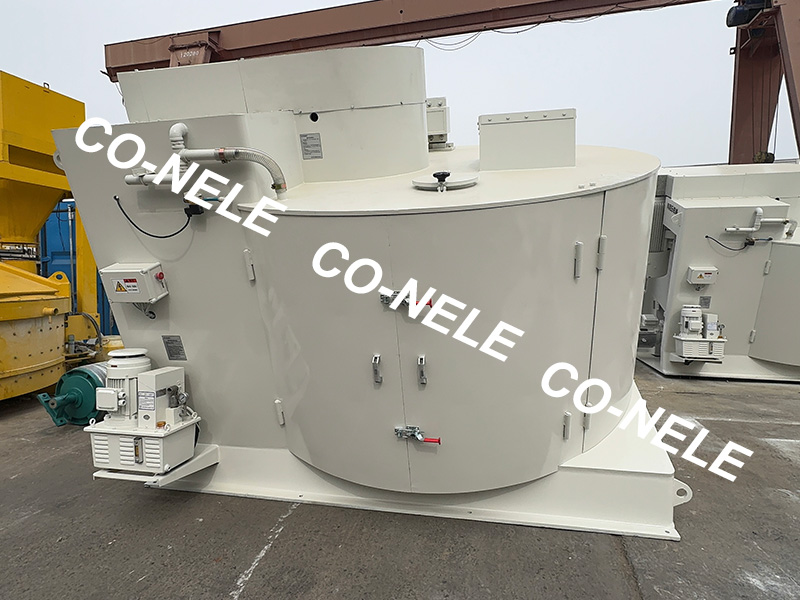"Pelletizing Metallurgical Intensive Mixer" is one of the key core equipment in the pelletizing production process. It is specially used for high-intensity, high-efficiency and high-uniformity mixing and granulation of materials such as iron ore powder, binder (such as bentonite), flux (such as limestone powder) and return ore.
Introduction to CO-NELE Pelletizing Intensive Mixer
Uniform mixing: Ensure that various raw materials (especially trace binders) are highly evenly distributed on the surface and inside of the ore powder particles, which is the basis for subsequent pelletizing and pelletizing quality (strength, composition uniformity, metallurgical properties).
Granulation/pre-balling: During the strong mixing process, fine particles (iron ore powder, binder, etc.) collide, adhere and agglomerate with each other under the action of mechanical force and liquid surface tension (usually need to add appropriate amount of water) to form small mother balls (or "quasi-particles" and "micro-balls") with a certain strength. This greatly improves the balling efficiency and pellet quality of the subsequent disc or cylinder ball making machine.
Working principle of pelletizing Intensive Mixer:
The core components of the strong mixer are a high-speed rotating rotor (mixing tool with a specific shape) and a rotating mixing tank (barrel).
The material is subjected to strong impact, shearing, convection and diffusion by the high-speed rotor in the mixing tank. The rotor tool throws the material to the barrel wall, and the barrel wall structure (such as fixed scraper, lining plate design) guides the material back to the rotor action area, forming a violent material circulation and compound movement.
This high-intensity mechanical energy input is the key to distinguishing it from ordinary mixers or traditional mixers. It can effectively break the agglomeration between raw material particles, overcome the cohesiveness of the material, and force the material particles to produce violent relative movement, thereby achieving highly uniform mixing on a microscopic scale and promoting the agglomeration of fine particles into mother balls.
Advantages of pelletizing intensive mixer:
High mixing intensity: high rotor linear speed (usually up to 20-40-m/s) and high energy input density.
High mixing uniformity: It can achieve microscopic mixing uniformity that is difficult to achieve with traditional equipment in a very short time (usually tens of seconds to minutes), especially for the dispersion of trace components.
High-efficiency granulation: It can complete the two key steps of mixing and pre-balling at the same time. The generated mother balls have uniform particle size (usually in the range of 0.2-2mm), dense structure and good strength, providing high-quality raw materials for subsequent balling.
Strong adaptability: It can handle materials of different particle sizes, different humidity and different viscosities, and has a relatively high tolerance for raw material changes.
High production efficiency: short mixing/granulation time and large single-machine processing capacity.
Energy saving: Although the single input power is large, due to the short mixing time and good effect, the energy consumption per unit output may be lower than that of traditional processes.
Improve subsequent processes: Provide more stable raw materials for balling and roasting processes, improve balling rate, pellet strength, uniformity and output, and reduce binder consumption.
Compact structure: It usually occupies a relatively small area.
Good airtightness: It is easy to achieve closed operation, reduce dust escape, and improve the working environment.
Position in the pellet production process:
Usually located after the batching system and before the pelletizer (disc or cylinder).
Basic process: batching bin → quantitative feeding → strong mixer (mixing + pre-balling) → pelletizer (rolling the mother ball into qualified green balls) → screening → roasting → cooling → finished pellets.
The pellet metallurgical strong mixer is the standard core equipment of modern efficient and large-scale pellet production lines. It achieves ultra-uniform mixing and efficient pre-balling of materials in a very short time by applying high-intensity mechanical energy, laying a solid foundation for subsequent pelletizing and roasting processes, and plays a vital role in improving the output and quality of pellets and reducing production costs (especially binder consumption). Its performance directly affects the technical and economic indicators of the entire pellet production line.
Post time: Jun-30-2025








